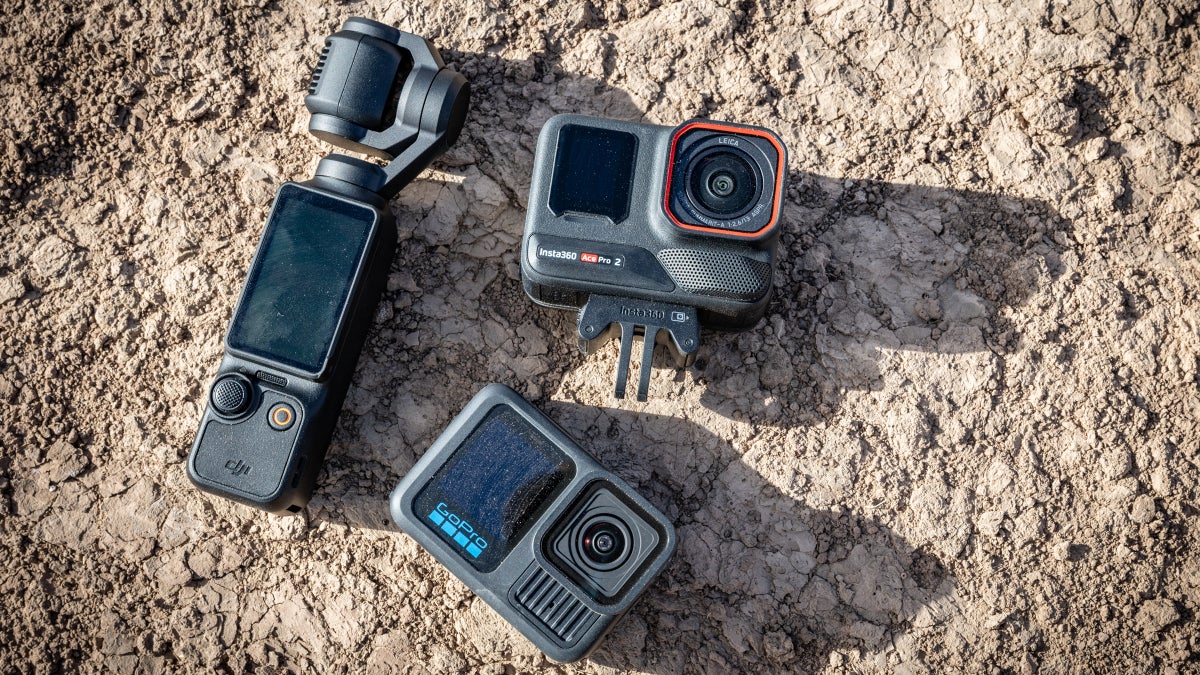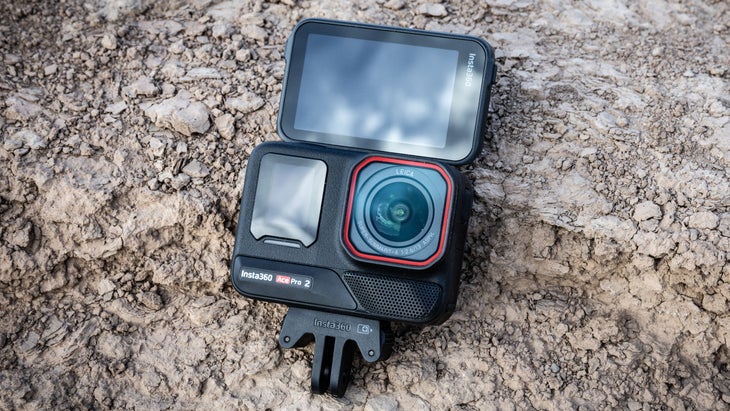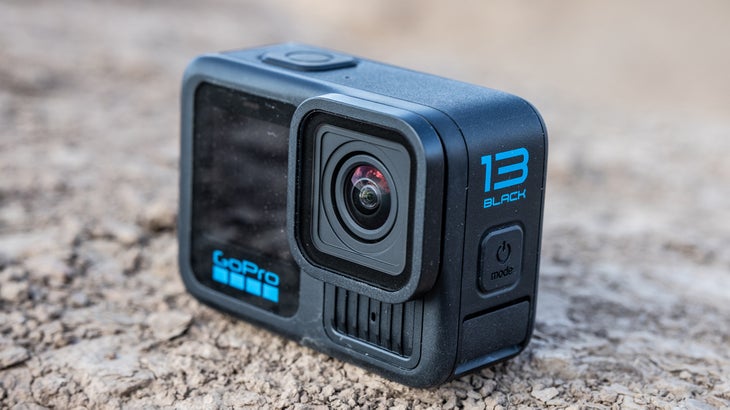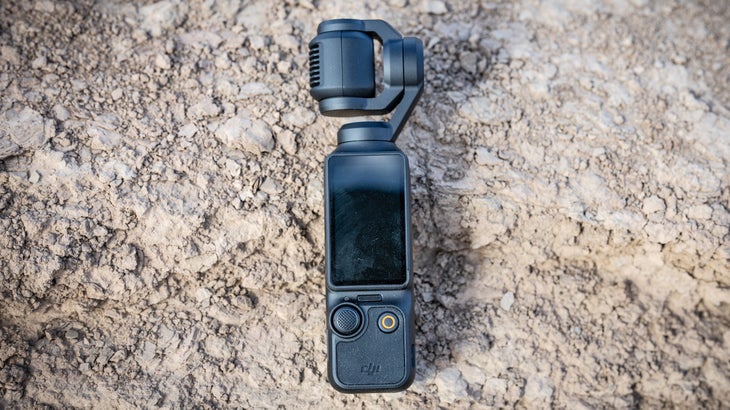
Creating high-quality video content has never been easier. Small action cameras now feature powerful sensors that capture stunning footage day or night, mind-boggling stabilization, and easy integration with quality wireless mics. But remember that your video is only as good as your adventure, so get out and get after it.
At a Glance
- Best Overall: Insta360 Ace Pro 2 ($360)
- Best GoPro Update: Hero13 Black ($330)
- Best for Beginners: Osmo Pocket 3 ($619)
- How to Choose an Action Camera
- How We Test
- Meet Our Lead Testers

Best Overall
Insta360 Ace Pro 2
Sensor Size: 1/1.3″
Weight: 6.3 ounces
Battery Capacity: 1800mAh
Pros and Cons
⊕ Buttery stabilization
⊕ Nice low-light footage
⊕ Great color profile
⊗ No need for 8K video
GoPro and DJI have long dominated the action camera market, but Insta360 takes over this year with the Ace Pro 2. Co-engineered with Leica, the camera shoots ultra high-resolution footage, rich 4K slow-mo, and captures high-quality audio. It also has a laundry list of amazing features, including a dedicated chip to help with low-light shooting, a back screen that flips up for great selfie footage, and industry-leading stabilization.
The total package makes it nearly impossible to shoot bad footage. No matter what we were doing—skiing, cycling, overlanding, etc.—the Ace Pro 2 produced video that we were always excited to edit and share. Shooters with more experience will find it easy to dial in custom settings, but the camera’s user interface was also easy to navigate for testers who had less experience.
Insta360’s accessory ecosystem is not as big as GoPro’s, but there is still plenty to choose from, including chest and handle-bar mounts, tripods, fast-charge battery packs, and ND filter sets. The company is not pushing integration with wireless mics, but it’s easy to pair a mic from a company like DJI to improve the quality of interviews or narration.
We were hard-pressed to come up with any critiques of the Ace Pro 2. Just one comment: No one really needs 8K footage on an action cam. That kind of resolution is overkill for social media (even YouTube), which is where most action-cam footage ultimately ends up.

Best GoPro Update
Hero13 Black
$330 at GoPro $330 at Best Buy
Sensor Size: 1/1.9″
Weight: 5.6 ounces
Battery Capacity: 1900mAh
Pros and Cons
⊕ Better battery life than previous model
⊕ Class-leading accessories
⊕ Great color profile
⊗ No upgrade to the sensor
The new Hero13 comes with two big upgrades. First, it includes a higher capacity 1900mAh battery that lasts up to 2.5 hours (depending on settings) and is now the standard for all of GoPros flagship cameras (we can hear videographers cheering from here). And second, GoPro has expanded its already robust accessories ecosystem by adding a suite of lenses you can slap on the new camera.
Related: Is the GoPro Hero13 Black Better Than the GoPro Hero?
These include an ultra-wide lens ($100) to increase the field of view, making it 36 percent wider and 48 percent taller, and a macro lens ($130) that lets you get up close and personal with small things like tiny animals or flowers. GoPro also just released its new Anamorphic lens ($130), which allows shooters to capture pro-level cinematic-quality footage. When you affix any of these lenses, the GoPro automatically recognizes it and adjusts its settings accordingly.
We’re fans of accessory lenses because they provide different perspectives: a new way of seeing and of capturing content. These days, all action cameras offer amazing resolution and stabilization; if you want to capture unique footage, different lenses open up new avenues for creativity. We hope that other action camera companies follow GoPros lead in this department.
GoPro plopped the same sensor from the Hero12 into the Hero13, so there’s no bump in resolution or low-light video quality. GoPro has been criticized for this, butit doesn’t bother us much because the lens integration is what you’re buying with the Hero13.
The biggest downside to the Hero13 is that the new lenses have to be purchased separate from the camera and its included standard lens. As a bundle, all three lenses cost $360. But we think that’s a smart, long-term investment since these lenses will likely be used with, and outlive, the 13, 14, and other GoPros to come.

Best for Beginners
DJI Osmo Pocket 3
Sensor Size: 1″
Weight: 6.3 ounces
Battery Capacity: 1300 mAh
Pros and Cons
⊕ Easy to use
⊕ Great stabilization
⊕ Best for social
⊗ Lower quality footage
It’s not lost on us that the most expensive action cam on this list is one we recommend for beginners. It would be cheaper to get a GoPro, but we think this camera’s user-friendly design makes it a worthwhile investment for novices.
Most action cams are designed to be attached to accessories like tripods, monopods, and various grips to capture footage on the go. The Osmo Pocket 3, on the other hand, is an all-in-one unit with an easy-grip handle and built-in three-axis stabilizer, which allows you to grab the camera at a moment’s notice, hit the power switch, and start recording silky smooth 4K footage almost immediately. We also love the two-inch screen that you can flip vertically to record social footage and keep horizontal to record wide-angle footage that’s great for YouTube.
DJI makes the best wireless mics on the market and they seamlessly plug and play with the Osmo Pocket 3 so you can record interviews or film yourself with high-quality sound. If you’re vlogging, you can also set the camera down and tell it to lock onto your face so you stay in focus while walking around within the frame.
While this camera isn’t designed to be strapped to a mountain bike (the built-in handle gets in the way), we have reliably used it to capture decent action footage while skiing. It can’t compete with the likes of GoPro or Insta360 in this department, but it’s a great option for traveling and hiking.
One note: the Osmo 3 has been around for a while. While it’s still available for sale, we’d be willing to bet that DJI is working on an update.
How to Choose an Action Camera
Purchasing an action cam is just like buying a bike or a set of skis in that you need to think first and foremost about how you will use it. Invest in a GoPro if you want a huge ecosystem of accessories, go for the Insta360 if quality footage is what matters most, and we suggest the Osmo Pocket 3 if social is where most of your videos will land.
You’ll need to look elsewhere if you plan to produce full-length documentaries. Action cams are best for gathering shorter videos that go on social platforms or that get spliced into longer edits. Take Cody Townsend’s “The Fifty” for example: He had a full-time videographer, Bjarne Salén, who used pro cameras to capture most of the footage. Townsend was also filming with a GoPro so that we could see his first-person perspective, but the editors would only include his footage when it made sense.
Storing and Editing Video Footage
It’s easy to shoot fun footy, but without proper organization and equipment, it can be a pain in the ass to store and edit. Make sure you have a hard drive that’s big enough to store video footage (we suggest you start with something that’s at least 10 or 12 terabyes), and use a naming convention that’s easy to search so you can go back and find the footage you shot last month, or last year.
On the editing side, there are lots of apps such as Capcut that will help you splice your best clips together to create a short Instagram reel, but they can’t help you produce a thoughtful three-minute mini documentary. If you want to create something longer, you’ll need to learn how to use video editing software such as Adobe Premier Pro.
Battery Life
Always invest in extra batteries. Companies say their batteries will last hours, but they never do, so it’s important to have at least two extra batteries on hand if you’re on an all-day adventure.
How We Test
- Number of Testers: 5
- Number of Products Tested: 10
- Hours of footage captured: 20+
- Number of times we jokingly said “footy” and “gnar”: 100+
- Highest elevation while testing: 10,500
- Coldest temp while testing: 0°F
Camera geeks are the best testers because they’re geeks. While most people just want to start shooting, the geeks also want to dig into the minutia and spend hours debating the merits of one camera versus the other. Thankfully our camera geeks have gotten good at digging into the details but then backing out and putting themselves in the shoes of the regular consumer so they can make recommendations based on general use.
For this year’s test we sent cameras on a wide variety of adventures and told testers to push the limits to find out where they failed. One tester took his camera on a full-moon skin to see how well the low-light option worked. While you could make out what was happening, the footage was not pretty to look at, letting us know that while action cams have come a long way, they’re still not as good as a bigger pro-level camera.
Meet Our Lead Testers
Category manager Jakob Schiller was a gear editor at Outside and is now a columnist. The father of four kids and two dogs, he’s a bit pinned down but still manages to run, ski, or bike every day and often brings a camera with him. Sometimes he nails the footage. Sometimes it’s total junk.
Gabe Zambello can’t sit still so he’s always thinking up an adventure like driving all the way to Alaska, raving in the Nevada desert, or riding his motorcycle up mountain roads. It’s easy to hand him a camera and tell him to push record.
More Gear Reviews
The Best Mirrorless Cameras for Novices to Pros
The Best Tents for Camping in Comfort and Style
The Best Trailers and Campers for Off-Grid Adventures
The post The 3 Best Action Cameras of 2025 appeared first on Outside Online.















